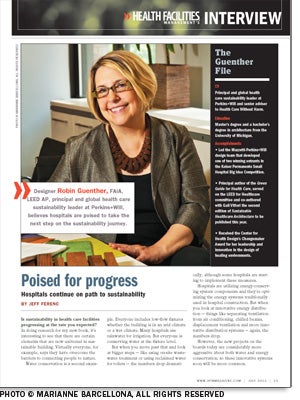Poised for progress
 Designer Robin Guenther, FAIA, LEED AP, principal and global health care sustainability leader at Perkins+Will, believes hospitals are poised to take the next step on the sustainability journey.
Designer Robin Guenther, FAIA, LEED AP, principal and global health care sustainability leader at Perkins+Will, believes hospitals are poised to take the next step on the sustainability journey.
Is sustainability in health care facilities progressing at the rate you expected?
In doing research for my new book, it's interesting to see that there are certain elements that are now universal in sustainable building. Virtually everyone, for example, says they have overcome the barriers to connecting people to nature.
Water conservation is a second example. Everyone includes low-flow fixtures whether the building is in an arid climate or a wet climate. Many hospitals use rainwater for irrigation. But everyone is conserving water at the fixture level.
But when you move past that and look at bigger steps — like using on-site wastewater treatment or using reclaimed water for toilets — the numbers drop dramatically, although some hospitals are starting to implement these measures.
Hospitals are utilizing energy-conserving system components and they're optimizing the energy systems traditionally used in hospital construction. But when you look at innovative energy distribution — things like separating ventilation from air conditioning, chilled beams, displacement ventilation and more innovative distribution systems — again, the numbers drop.
However, the new projects on the boards today are considerably more aggressive about both water and energy conservation, so these innovative systems soon will be more common.
The last 10 years were about getting hospitals to think about sustainability and to do something. Now we've defined baselines, the low-hanging fruit and what it means to be more innovative. It's gaining momentum despite the financial challenges of the past few years.
Is it getting easier to convince hospital leadership about the benefits of sustainability?
The C-suite is more receptive than ever before about first costs balanced against operational savings. Five years ago, that was a more difficult conversation, but as energy gets more expensive, the financial benefits of conservation become clearer. There are better decision-making tools.
CEOs are in a unique position because their job is to lead where no one has gone and to make leadership decisions when there isn't a proven business case and much is unknown. That's the very definition of a CEO.
There are hospital CEOs who understand that sustainability is a powerful community engagement tool. It's a powerful leadership tool. People who are trying to motivate and retain clinical staff are finding that sustainability is a powerful staff engagement tool.
Is sustainability becoming mainstream in hospitals?
If you're asking whether we've reached the tipping point, yes, we're there. If creating the tipping point takes the wisdom of a few, a stickiness factor and a larger context, all those things are in place.
We have enough built examples, we have enough stickiness from policy measures, and the Healthier Hospitals Initiative is creating a powerful context for the work. In addition, hospitals keep connecting the dots between improving occupant and community health and having a healthy environment that embeds sustainable design as a key element of the health care mission. We have innovators, early adopters and the early majority on board.
At the same time, we have not yet moved past the early majority to really make sustainability mainstream. I don't think it's a question of the timetable as much as it is a certain set of conditions that are going to cause the late majority to embrace these challenges.
What will be required? It may be a spike or continued rise in energy and water prices or continued regulatory movement to more aggressive energy codes or emission standards. It may be that a marketplace that favors new healthier buildings will push it along. Maybe it will be Kaiser Permanente's decision to build the next $30 billion in new construction to minimum LEED Gold standards.
The learning curve of the design professionals is also part of it. As more firms get more experience in sustainable building, both the engineering and architecture communities will move the late majority. They will tell hospitals, "You can do that. We've done it before. It doesn't cost more to be sustainable."
What can a hospital new to sustainability hope to achieve in energy savings?
The foundation of Gundersen Health System's goal to achieve net zero or energy independence is energy conservation. The La Crosse, Wis., system saved 25 percent of its total energy through targeted energy conservation measures. Partners HealthCare, Boston, has identified 20 percent savings through efficiency measures.
That's the first step for all hospitals — do your conservation work.
Are hospitals looking at their impact on carbon emissions?
Leading health care systems are measuring and actively moving to reduce their building greenhouse gas emissions by 30 to 50 percent. Partners HealthCare, which has agreed to comply with the Massachusetts Global Warming Solutions Act, has a strategic master plan to cut its building carbon emissions by 40 to 50 percent. That's an incredible goal and they're moving on it.
People are getting more interested in carbon emissions as they make the connection between carbon and health. Carbon emissions make people sick and may well be impacting weather patterns.
When you see academic medical centers convening conferences on climate change and human health, you know that someone in that medical school C-suite is going to talk to the hospital next door about their carbon footprint. That's starting to happen.
Can hospitals still be sustainable regardless of size and the level of amenities they offer?
Yes, hospitals of any size, from critical access to large urban academic medical centers, are building and operating more sustainably.
If we think that sustainability is inherently about deprivation, then we believe that we get less quality for less resource use. If we think sustainability is about getting the same or better performance for less resource use, then it's a win-win.
I see a lot of predisposition in the industry that sustainability is about less for less. So, for example, if you want to save water, you're going to have fewer hand-washing sinks because, aren't you trying to save water?
If you use low-flow devices, you have a greater number of hand-washing sinks using the same amount of water as a comparable restroom with fewer hand-washing sinks. So, you can do a better of job of hand washing for the same water usage in a sustainable building.
I would challenge all of us to interview one sustainable building owner that really believes they got a lesser building because it is sustainable. By lesser I mean a lesser operating building, lower light levels, fewer air changes.
Finally, are smaller community-embedded hospitals the wave of the future?
I think that's going to happen, absolutely. There will be health care in offices, in schools, primary health care in venues that are not purpose-built spaces. There still will be the medical office building that aggregates specialty care because multiple specialists in one place are required for complex diagnostics.
Community hospitals will be backed up by hospitals embedded in the community and that share these multispecialty practices' diagnostic space such as ORs and imaging.
| Sidebar - The Guenther File |
| CV: Principal and global health care sustainability leader at Perkins+Will and senior adviser to Health Care Without Harm. Education: Master's degree and a bachelor's degree in architecture from the University of Michigan. Accomplishments: • Led the Mazzetti-Perkins+Will design team that developed one of two winning entrants in the Kaiser Permanente Small Hospital Big Idea Competition. • Principal author of the Green Guide for Health Care, served on the LEED for Healthcare committee and co-authored with Gail Vittori the second edition of Sustainable Healthcare Architecture to be published this year. • Received the Center for Health Design's Changemaker Award for her leadership and innovation in the design of healing environments. |



